From maize meal to vegetables
A healthier alternative for disadvantaged learners
After 30 years of the Namibian School Feeding Programme - subsidised by government, a new programme has been introduced.
More than 500 000 children across the country are currently dependent on the Namibian School Feeding Programme (NSFP).A daily portion of 125g of maize meal - that contains soya for protein, sugar and salt - is given to learners. This is known as a maize blend, which is usually these learners’ only meal for the day.
The programme is rolled out countrywide in 80% of regions, feeding learners at 1 500 schools.
The yearly budget for the feeding programme costs the ministry of education, arts and culture a total of N$80 million every year.
The ministry currently has no supplier for the maize blend, Edda Bohn, its deputy executive director said.
The Central Procurement Board of Namibia has yet to provide them with an international supplier as there are no local suppliers of soya, she said.
Meanwhile, a new feeding programme has been introduced in addition to the old programme.
The Home-Grown School Feeding Programme (HGSFP) was designed to feed learners from marginalised communities as well as tackle poverty in the country. According to a presentation by Bohn at a transforming education pre-summit in Paris, the new programme will provide more opportunities for farmers.
She said the new feeding scheme was implemented last year and, according to a document received from the team on the ground implementing the feeding scheme, it was started in August 2021 in 19 schools and will continue for a maximum of seven months in the 2022/2023 financial year. Small farmers and producers make up a total of 153 suppliers of ‘basic vegetables’ for the HGSFP.
The project is currently running in seven regional directorates, which are the Kunene, Ohangwena, Kavango East, Kavango West, Zambezi, Omaheke and Hardap regions. Furthermore, the food items are procured through local producers within the vicinity of the schools.
“Some areas work well, like Mariental and Stampriet where there are currently local producers,” Bohn said. She further emphasised that to expand the project, “a market for the community in the community has to be created”.
Going forward
Going forward, the ministry - through partnerships - would like to expand the programme by combining the two feeding schemes. In practice, the idea is to provide learners with the diversified meal three times a week and the maize blend two times a week.
The NSFP was implemented in 1992 and was originally funded by the World Food Programme. The ministry took over the feeding programme in 1996. Semi-arid regions are targeted through the programme and it aims to assist in improving the concentration and attendance of learners.




Comments
My Zone
No comments have been left on this article